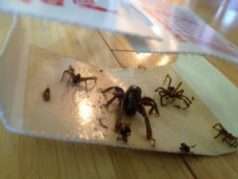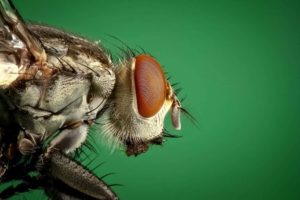BENEFITS OF STICKY TRAPS IN YOUR ARIZONA HOME
Sticky traps are great Eco-friendly pest control tools for a wide variety of pests. They work on pests ranging from smaller pests like bed bugs, cockroaches, and recluse spiders to larger pests like scorpions and mice. Incorporating safe and toxic-free sticky traps are a part of a 360-degree pest control elimination strategy making sure your home and garden are free of unwanted pests.
Sticky traps contain a sticky-like glue layer that’s attached to a flat board of cardboard. They’re extremely efficient in trapping bugs and insects of all kinds, as well as mice. They can be placed on the sides of walls, vents, doorways, or on the floor in the paths that insects and bugs often travel. They are even sticky traps that people can position around their bed to trap bed bugs. There are also hanging sticky traps that are good for catching flying insects, these are particularly useful for greenhouses. Glue traps are also a form of sticky trap that is considered more heavy duty and are particularly efficient at trapping large mice and rats.
4 Types of Pest Control
- Chemical Pest Control.
The chemical method involves uses chemical treatments to deter any kind of pest. Chemical treatments tend to be one of the most popular types of control due to its effectiveness. Chemical pest control, particularly space fumigation, tends to work best for severe infestations.
You can opt for organic chemical treatments, with botanic or fermented products used to exterminate pests. There are also near-organic insecticides and synthetic insecticides to use.
- Biological Pest Control.
Biological control involves the use of living organisms to control a pest population. Parasites, plant pathogens, and predators are often introduced as biological control agents. For instance, the spotted lady beetle will feed on the larvae of Colorado potato beetles. Chalcid wasps are parasites that will feed on whiteflies. Certain strands of bacteria, fungi, and viruses can naturally infect a variety of pests.
Bigger predators include ferrets, dogs, and cats. Throughout history, ferrets, mongooses, and cats were often trained to hunt after snakes and rodents that infested rural areas.
- Electronic Pest Control.
Recent technological advances have allowed for alternative ways of dealing with pest problems. Electromagnetic gadgets will target the nervous systems of certain species, repelling mice, rodents, arts and other insects. Ultrasonic devices are also used to emit high frequency sound ways that affect small vermin species.
- Physical Pest Control.
People who lack chemical, biological and electronic means of controlling a pest population will often rely on physical methods. Physical pest control uses natural barriers like nets or plastic sheets to protect crops.
Green & Organic Pest Control
The terms “green,” “organic,” and “natural” have no official definitions. This means that any company can use these words however they choose—and without any regulations to adhere to.
Example: Pyrethrin (pronounced “py-REE-thrin”) is a natural organic compound derived from Chrysanthemums, a family of flowering plants. This compound contains insecticidal properties that are very effective against a variety of pests. Synthetic pyrethroids—meaning they are manmade—are also effective pest control products. Since synthetic pyrethroids work just like pyrethrin (and are based upon the naturally derived compound itself), some companies will classify these synthetic pyrethroids as “green” and include them in their green services.
But when we says a product is “natural,” we mean it literally. All of the products we use in our Natural Choice programs are actually naturally derived and do not have any synthetic properties.
Integrated Pest Management (IPM)
For years, Integrated Pest Management (IPM) has been the buzz in our industry. IPM stands for a standard of pest control seldom realized in practice. It stands for using non-chemical approaches for pest control whenever possible and practical. In practical terms, it means:
Caulking and filling cracks and holes on the outside of your house to keep the bugs from coming in the first place
Modifying habitats, both outside and inside, to take away a pest’s harborage
Controlling food sources to deny pests food
Targeting the bugs where they live with the least toxic material needed to kill them
Some of these things WE can do, and some YOU must do. By working with Arizona Organic Pest & Termite Control, we will be more successful than an approach that simply sprays poison on everything and hopes the right things die.
By practicing integrated pest management, we can solve your pest problems with our low to non-toxic, natural pesticides. We use organic products derived from plants to inorganic products mined from the ground, and we get results as good as, or better than, regular pest & termite control practices.

Seal Your Home
Make sure all Weather-Stripping around your homes doors (including your garage doors) are in good order and replace as needed.
SCREEN vents that enter your hoe from the exterior, don’t forget the ones on top of your home!
Change exterior light bulbs to Yellow Lights ~ They’re less attractive to MANY MANY bugs like: beetles, crickets, moths, flies & insects that feed on them like scorpions!
Silicone CAULK around doors & windows to seal any holes.
Remove concrete expansion joints, and fill with Concrete Caulk.
Silicone CAULK all block fence “I” blocks.
To make pest control treatments MUCH more effective, PAINT or waterproof your block wall fence! Waterproof Acrylic Sealer prevents pest control product applications from being absorbed into the blocks
Add or replace Door Sweeps to exterior doors especially if they’re missing, old, or worn.
